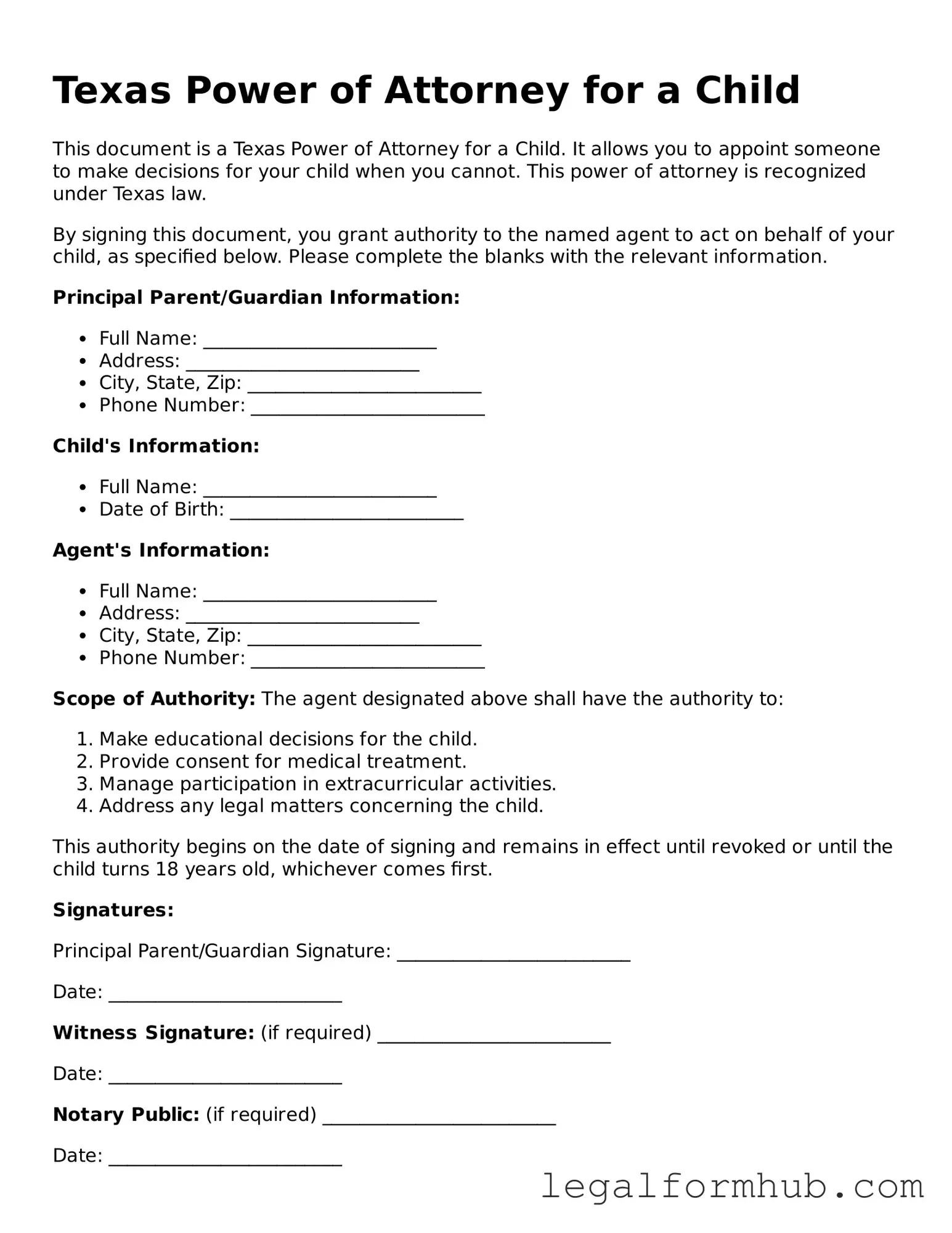The Texas Power of Attorney for a Child form shares similarities with the General Power of Attorney. Both documents grant authority to an agent to make decisions on behalf of another individual. In the case of the General Power of Attorney, this authority can cover a wide range of matters, including financial and legal decisions. However, the Power of Attorney for a Child is specifically tailored to address the needs and welfare of a minor, focusing on decisions related to their care, education, and health, rather than broader financial matters.
Another document that resembles the Texas Power of Attorney for a Child is the Medical Power of Attorney. This form allows an individual to designate someone to make medical decisions on their behalf if they become unable to do so. Similar to the Power of Attorney for a Child, the Medical Power of Attorney emphasizes the importance of having a trusted person in charge of critical decisions. However, it is specifically concerned with healthcare matters, while the Power of Attorney for a Child encompasses a wider range of responsibilities related to a child's upbringing.
The Child Custody Agreement is also comparable to the Texas Power of Attorney for a Child. Both documents are designed to ensure that a child's best interests are prioritized. A Child Custody Agreement outlines the living arrangements and responsibilities of parents or guardians. In contrast, the Power of Attorney for a Child allows a designated agent to act on behalf of the parent or guardian, providing flexibility in temporary situations, such as travel or emergencies, without altering custody arrangements.
The Guardianship Agreement bears similarities as well. A Guardianship Agreement is a legal document that appoints someone to care for a minor when their parents are unable to do so. Like the Power of Attorney for a Child, it focuses on the welfare of the child. However, guardianship often involves a more permanent arrangement, while the Power of Attorney is typically intended for temporary situations, allowing for immediate care without the need for a court process.
The Consent for Medical Treatment form is another document that aligns with the Texas Power of Attorney for a Child. This form allows a parent or guardian to grant permission for a healthcare provider to treat their child. Both documents ensure that a child can receive necessary medical attention. However, while the Consent for Medical Treatment is limited to healthcare decisions, the Power of Attorney for a Child encompasses a broader spectrum of responsibilities, including education and general welfare.
In Arizona, understanding the importance of a Non-disclosure Agreement (NDA) is crucial for individuals and businesses alike, as it offers a legal framework to maintain the confidentiality of shared information. An NDA, such as the one available at arizonapdfs.com/non-disclosure-agreement-template/, ensures that sensitive details remain secure, fostering trust and promoting open communication between parties while protecting their respective interests.
The Temporary Custody Agreement is similar in that it provides a framework for the temporary care of a child. This document is often used when parents need someone else to look after their child for a limited time. Like the Power of Attorney for a Child, it allows another adult to step in and make decisions for the child. However, the Temporary Custody Agreement usually involves more formal legal proceedings, whereas the Power of Attorney can be executed more quickly and informally.
The Child Care Authorization form also shares common ground with the Texas Power of Attorney for a Child. This document allows parents to authorize another person to care for their child, often for a specific period. Both forms facilitate the delegation of parental authority, ensuring that the child’s needs are met. However, the Child Care Authorization is typically more focused on day-to-day care, while the Power of Attorney for a Child provides broader decision-making powers.
The Release of Liability form is another document that has a similar purpose in certain contexts. This form is often used in situations where parents want to allow their child to participate in activities that may involve some risk, such as sports or field trips. While it does not grant decision-making authority, it does ensure that parents can designate someone to act on their behalf in case of emergencies. The Power of Attorney for a Child, on the other hand, provides comprehensive authority for a range of decisions beyond just liability concerns.
Finally, the Affidavit of Parentage is akin to the Texas Power of Attorney for a Child in that it establishes legal relationships concerning a child. This document is used to affirm the parental status of individuals, which can be crucial in custody or support matters. While it does not grant authority to make decisions for the child, it serves to clarify parental rights, which can complement the powers granted in a Power of Attorney for a Child when determining who can act on behalf of the child.
